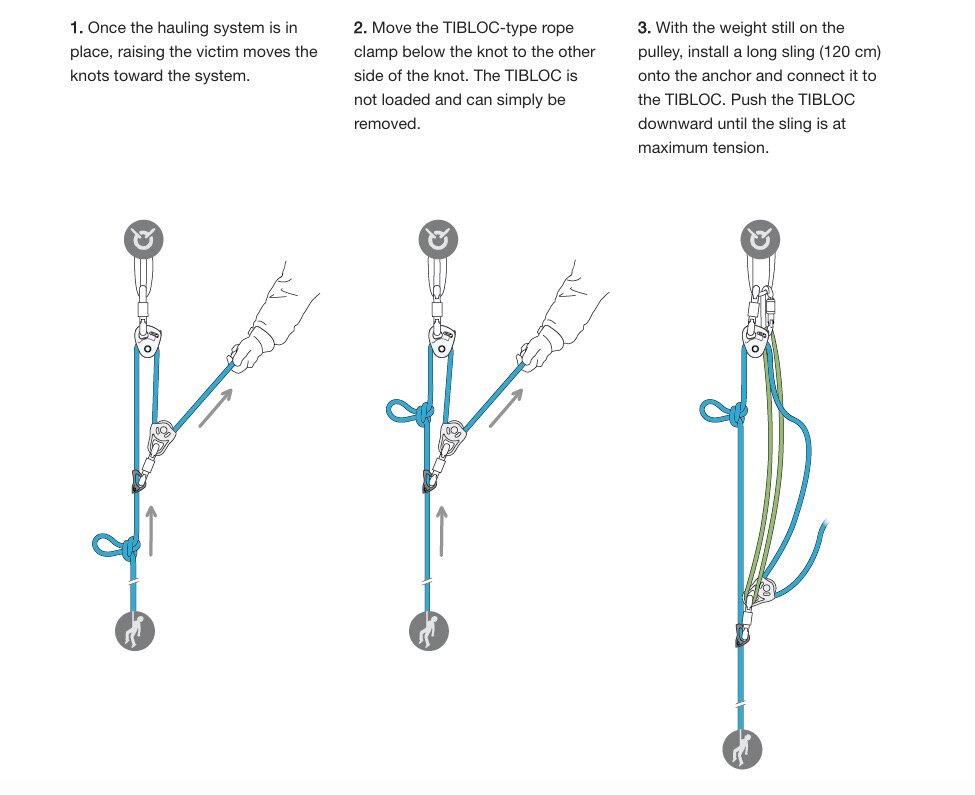Dealing with brake knots in crevasse rescue
Credit to the Petzl graphic design experts for the diagrams below, from the always terrific Petzl website.
IMAGE: HTTPS://WWW.YOUTUBE.COM/WATCH?V=QHW9AM7AHLA
As a climber, when might you have to deal with knots in a hauling system? Maybe in two person crevasse rescue, where you’re following best practice (with one other highly skilled partner, who has all needed gear, and their rescue skills dialed) and using brake knots in the rope. Or maybe big wall climbing, where you want to do a super long haul from the ground tying several ropes together, to get your bags up several pitches all with one haul.
Untying a knot from a loaded rope (or getting a knot past the hauling pulley) can be tricky, but it doesn't have to be if you follow the steps below. This is one of various ways to do it. Initially this might look a little complicated, but it's actually a simple procedure. Study it for a bit and I'm sure you'll get the hang of it.
Note: In this example, for a 3:1 mechanical advantage (MA) system crevasse rescue, the knots are being untied. For big wall load hauling, you’ll probably be using a 2:1 MA, the knots will very likely stay in the rope, and a different procedure is needed, which were not going to completely cover in this article.)
In the diagram, they’re using the Petzl Micro Traxion as a progress capture pulley on the anchor point, and a Tibloc as the “tractor” pulley to actually pull the load. These are two great pieces of gear and work fine here. However, you could also use pretty much any other sort of pulley, prusik and rope grab combination.
If you have more than one knot you need to pass, such as in a two person crevasse rescue, using the Tibloc is going to be faster, because you don't have to fumble with re-tying a prusik hitch at each knot pass. Best practice for using brake knots in glacier travel to have three or four of them between climbers, so you're probably going to repeat this process a few times.
Bigger picture, a more modern approach to crevasse rescue eliminates the problem of brake knots entirely. Lower either a single strand or a loop of rescue rope to your partner, and pull them up on this separate line. The original brake knots on the rope they fell in on? You can pretty much ignore them.
Here’s how to do it.
Haul until the knot gets close to the anchor.
Ease up on your haul and let the load rest on the anchor pulley. Move the unweighted Tibloc below the knot.
Clip a double length / 120 cm sling (green) to the anchor, clip the other end to the Tibloc, and push the Tibloc down the rope, tensioning the sling.
Do a short pull on the rope and open the toothed cam on the Traxion pulley. Lower the load slowly onto the sling. Check to see that everything is holding. (Tying a backup knot in the haul strand at this point is not shown in the diagram below, but might be a good idea.)
The load is now on the Tibloc, and you have slack above it. Untie the knot from the slack rope. (At this point, if the knot had to stay in the rope, you could extend the master point pulley on a 60 cm sling below the rope and reattach it.)
Engage the cam on the Traxion so it’s grabbing the rope again. Resume hauling. After one pull, unclip the sling from the Tibloc. If you have another knot to pass, keep the sling clipped to the master point. If not, you can remove it. Continue hauling.
image: https://www.petzl.com/BE/en/Sport/Crevasse-fall--hauling-on-a-rope-with-knots
image: https://www.petzl.com/BE/en/Sport/Crevasse-fall--hauling-on-a-rope-with-knots
Finally, here's a nice video clip from British IFMGA Certified Guide Dave Searle showing how it's done. (Dave has loads of great tips on his Instagram, check it out.)



